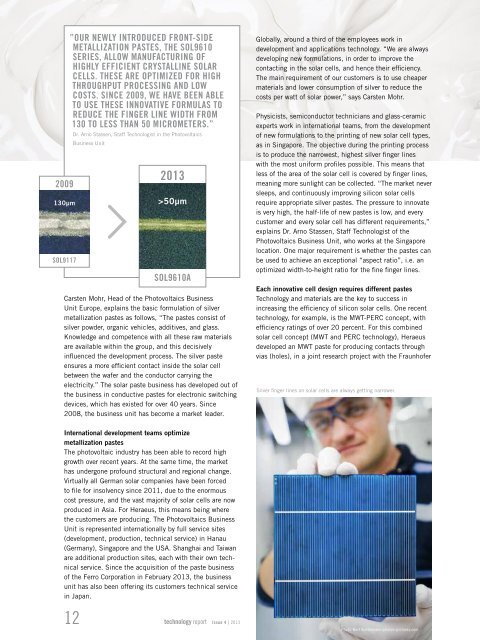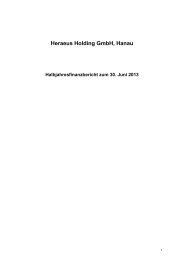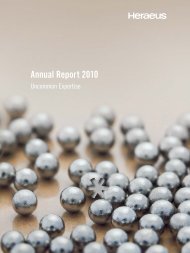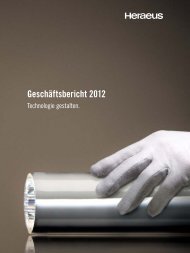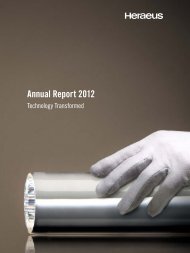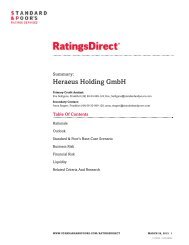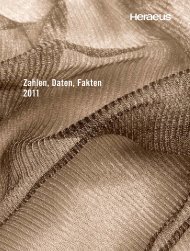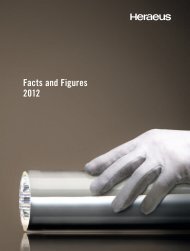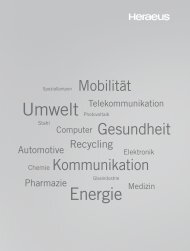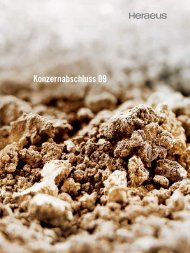technology report 04
technology report 04
technology report 04
Create successful ePaper yourself
Turn your PDF publications into a flip-book with our unique Google optimized e-Paper software.
2009<br />
130µm<br />
Sol9117<br />
”Our newly introduced front-side<br />
metallization pastes, the SOL9610<br />
Series, allow manufacturing of<br />
highly efficient crystalline solar<br />
cells. These are optimized for high<br />
throughput processing and low<br />
costs. Since 2009, we have been able<br />
to use these innovative formulas to<br />
reduce the finger line width from<br />
130 to less than 50 micrometers.”<br />
Dr. Arno Stassen, Staff Technologist in the Photovoltaics<br />
Business Unit<br />
2013<br />
>50µm<br />
SOL9610A<br />
Carsten Mohr, Head of the Photovoltaics Business<br />
Unit Europe, explains the basic formulation of silver<br />
metallization pastes as follows, “The pastes consist of<br />
silver powder, organic vehicles, additives, and glass.<br />
Knowledge and competence with all these raw materials<br />
are available within the group, and this decisively<br />
influenced the development process. The silver paste<br />
ensures a more efficient contact inside the solar cell<br />
between the wafer and the conductor carrying the<br />
electricity.” The solar paste business has developed out of<br />
the business in conductive pastes for electronic switching<br />
devices, which has existed for over 40 years. Since<br />
2008, the business unit has become a market leader.<br />
Globally, around a third of the employees work in<br />
development and applications <strong>technology</strong>. “We are always<br />
developing new formulations, in order to improve the<br />
contacting in the solar cells, and hence their efficiency.<br />
The main requirement of our customers is to use cheaper<br />
materials and lower consumption of silver to reduce the<br />
costs per watt of solar power,” says Carsten Mohr.<br />
Physicists, semiconductor technicians and glass-ceramic<br />
experts work in international teams, from the development<br />
of new formulations to the printing of new solar cell types,<br />
as in Singapore. The objective during the printing process<br />
is to produce the narrowest, highest silver finger lines<br />
with the most uniform profiles possible. This means that<br />
less of the area of the solar cell is covered by finger lines,<br />
meaning more sunlight can be collected. “The market never<br />
sleeps, and continuously improving silicon solar cells<br />
require appropriate silver pastes. The pressure to innovate<br />
is very high, the half-life of new pastes is low, and every<br />
customer and every solar cell has different requirements,”<br />
explains Dr. Arno Stassen, Staff Technologist of the<br />
Photovoltaics Business Unit, who works at the Singapore<br />
location. One major requirement is whether the pastes can<br />
be used to achieve an exceptional “aspect ratio”, i.e. an<br />
optimized width-to-height ratio for the fine finger lines.<br />
Each innovative cell design requires different pastes<br />
Technology and materials are the key to success in<br />
increasing the efficiency of silicon solar cells. One recent<br />
<strong>technology</strong>, for example, is the MWT-PERC concept, with<br />
efficiency ratings of over 20 percent. For this combined<br />
solar cell concept (MWT and PERC <strong>technology</strong>), Heraeus<br />
developed an MWT paste for producing contacts through<br />
vias (holes), in a joint research project with the Fraunhofer<br />
Silver finger lines on solar cells are always getting narrower.<br />
International development teams optimize<br />
metallization pastes<br />
The photovoltaic industry has been able to record high<br />
growth over recent years. At the same time, the market<br />
has undergone profound structural and regional change.<br />
Virtually all German solar companies have been forced<br />
to file for insolvency since 2011, due to the enormous<br />
cost pressure, and the vast majority of solar cells are now<br />
produced in Asia. For Heraeus, this means being where<br />
the customers are producing. The Photovoltaics Business<br />
Unit is represented internationally by full service sites<br />
(development, production, technical service) in Hanau<br />
(Germany), Singapore and the USA. Shanghai and Taiwan<br />
are additional production sites, each with their own technical<br />
service. Since the acquisition of the paste business<br />
of the Ferro Corporation in February 2013, the business<br />
unit has also been offering its customers technical service<br />
in Japan.<br />
12 <strong>technology</strong> <strong>report</strong> Issue 4 | 2013<br />
<strong>technology</strong> <strong>report</strong> Ausgabe 4 | 2013<br />
Photo: Bert Bostelmann/photon-pictures.com


